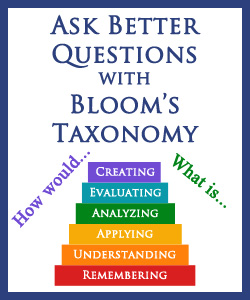
Do you ever find yourself running out of good questions for your homeschool lessons and discussions?
Never fear. Bloom is here.
As I explained in Use Bloom’s Taxonomy to Improve Your Homeschool, Dr. Benjamin Bloom developed a hierarchy of thinking and learning skills. This framework can be a source of inspiration for questions to ask your children.
There are different questions associated with each level of the taxonomy. I am going to share some of those with you today so that you can use them when you do lessons with your children.
There are a few things to keep in mind when using these questions. The taxonomy progresses from the most basic level of thinking (Remembering) to the complex (Creating). Generally speaking, young children function at the lower levels and progress to the upper levels as they get older. Every child is unique so the rate of growth can vary. Also, the level at which a child can answer questions may be different for each subject. For example, a child who is proficient in Language Arts may be able to answer higher level questions in that area but need to work at the lower levels in Science. That’s why it’s a good idea to test your child’s ability level once in a while by throwing in a higher level question.
Let’s look at the questions that you can use in your homeschool.
Bloom’s Taxonomy Questions
Remembering
Who was…?
Where was…?
When did…?
How did…?
What is…?
Why did…?
Which one is…?
Name the…
Find the…
List the…
What was this passage about?
How would you describe…?
Define…
Identify…
What happened when…?
How much…?
How many…?
What took place after…?
Who said…?
Who was it that…?
Who spoke to…?
Understanding
Explain in your own words…
How are…alike?
How are…different?
What does this mean?
What are they saying when they…?
What part doesn’t fit with…?
Give me an example of…
What was the main idea of…?
Outline the main points of…
What would happen if…?
Explain why…
What will probably happen…?
What could happen if…?
Who do you think will…?
What does this represent?
Which statements support…?
Summarize the…
Applying
What would you change…?
What are the effects of…?
What would result if…?
How much change would there be if…?
How is…related to…?
Why is…important?
Could this have happened if…?
How is this an example of…?
What do you think could have happened next?
Clarify…
How would you illustrate…?
Explain why the character…
Do you know of another instance when…?
How would you use this information to…
What questions would you ask the…?
Put these into groups of…
From what you have been given, can you develop instructions for…?
How would you solve this problem?
How would you apply what you have just learned to…?
Analyzing
What assumptions could you make about…?
If…had happened instead, how might the ending be different?
What is the motive for…?
What is the premise…?
What is the relationship between…?
What literary form is this?
What is the function of…?
What is his point of view on…?
What justifies…?
Are there any inconsistencies in…? If so, what?
What technique does he use to persuade…?
Describe the parts or features of…?
Classify…according to these guidelines.
Prove that…
Which are facts and which are opinions?
What conclusions can you draw…?
What could not have happened?
Why did these changes happen?
Identify the turning point in…
What are some of the problems with…?
What was the underlying theme?
What other outcomes are possible in this situation?
Can you distinguish between…?
Evaluating
Find the errors in…
What fallacies are there in…?
Do you agree with…? Why or why not?
What do you think about…?
What is the most important…?
How would you prioritize…?
What criteria would you use to evaluate…?
Is there a better solution to that problem?
How valuable is…?
How would you have dealt with that situation?
How would you feel if…?
What influence will that have on…?
What are the alternatives?
Who will gain and who will lose by this?
What is the logical choice in this situation?
Was that decision ethical?
What is the best, moral choice in this situation?
Was that an appropriate decision?
Is that reasoning valid?
Can you defend your position on…?
What changes would you recommend?
What are the pros and cons of…?
How did you come to that conclusion?
Creating
How would you design a…?
What would be a solution to…?
If you had these resources, how would you deal with…?
Devise your own way to…
How many ways can you come up with to…?
Give a rule for…
What is an alternative to…?
How would you find out if…?
Create a…
Come up with an invention for…
What are some new and unusual uses for…?
Develop a…
Brainstorm ways to…
Formulate a plan for…
Besides questions, this model can also be an inspiration for developing or improving lessons. You’ll find a list of lesson activities associated with Bloom’s Taxonomy HERE.








This is great, thank you! I’m always trying to work with my teen on answering higher level questions. We WILL move past 6th grade questioning!
I’m glad you found it helpful. Have a great year!